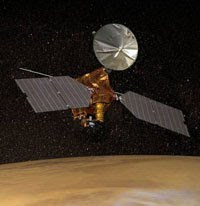
NASA's Mars Reconnaissance Orbiter (MRO) has discovered the total amount of atmosphere on Mars changes dramatically as the tilt of the planet's axis varies. This process can affect the stability of liquid water if it exists on the Martian surface and increase the frequency and severity of Martian dust storms. Researchers using MRO's ground-penetrating radar identified a large, buried deposit of frozen carbon dioxide, or dry ice, at the Red Planet's south pole. The scientists suspect that much of this carbon dioxide enters the planet's atmosphere and swells the atmosphere's mass when Mars' tilt increases. The findings are published in a report in the journal Science.
The newly found deposit has a volume similar to Lake Superior's nearly 3,000 cubic miles. The deposit holds up to 80 percent as much carbon dioxide as today's Martian atmosphere. Collapse pits caused by dry ice sublimation and other clues suggest the deposit is in a dissipating phase, adding gas to the atmosphere each year. Mars' atmosphere is about 95 percent carbon dioxide, in contrast to Earth's much thicker atmosphere, which is less than .04 percent carbon dioxide. "We already knew there is a small perennial cap of carbon-dioxide ice on top of the water ice there, but this buried deposit has about 30 times more dry ice than previously estimated," said Roger Phillips of Southwest Research Institute in Boulder, Colo. Phillips is deputy team leader for MRO's Shallow Radar instrument and lead author of the report.
"We identified the deposit as dry ice by determining the radar signature fit the radio-wave transmission characteristics of frozen carbon dioxide far better than the characteristics of frozen water," said Roberto Seu of Sapienza University of Rome, team leader for the Shallow Radar and a co-author of the new report. Additional evidence came from correlating the deposit to visible sublimation features typical of dry ice. "When you include this buried deposit, Martian carbon dioxide right now is roughly half frozen and half in the atmosphere, but at other times it can be nearly all frozen or nearly all in the atmosphere," Phillips said.
The newly found deposit has a volume similar to Lake Superior's nearly 3,000 cubic miles. The deposit holds up to 80 percent as much carbon dioxide as today's Martian atmosphere. Collapse pits caused by dry ice sublimation and other clues suggest the deposit is in a dissipating phase, adding gas to the atmosphere each year. Mars' atmosphere is about 95 percent carbon dioxide, in contrast to Earth's much thicker atmosphere, which is less than .04 percent carbon dioxide. "We already knew there is a small perennial cap of carbon-dioxide ice on top of the water ice there, but this buried deposit has about 30 times more dry ice than previously estimated," said Roger Phillips of Southwest Research Institute in Boulder, Colo. Phillips is deputy team leader for MRO's Shallow Radar instrument and lead author of the report.
"We identified the deposit as dry ice by determining the radar signature fit the radio-wave transmission characteristics of frozen carbon dioxide far better than the characteristics of frozen water," said Roberto Seu of Sapienza University of Rome, team leader for the Shallow Radar and a co-author of the new report. Additional evidence came from correlating the deposit to visible sublimation features typical of dry ice. "When you include this buried deposit, Martian carbon dioxide right now is roughly half frozen and half in the atmosphere, but at other times it can be nearly all frozen or nearly all in the atmosphere," Phillips said.
No comments:
Post a Comment